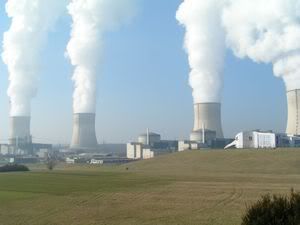Dale Klein, Chairman of the Nuclear Regulatory Commission (NRC), was interviewed on C-SPAN’s Newsmakers this last Sunday on October 22nd, 2006. Regarding twenty nine recent pending license requests for the construction of new nuclear power plants in the US, he stated that there will be a nuclear renaissance in the United States:
“I do believe that we will see license applications in 2007 and we are looking – we have expressions of intent from a lot of the utilities indicating up – as I said, up to about 29 new nuclear plants. So I believe that there will be a [nuclear] renaissance in the United States.”
The interview covered a broad range of nuclear issues, such as: Licenses and permits for pending US nuclear power plant construction, nuclear waste reclamation and the Yucca Mountain nuclear waste repository, the threat of terrorism against nuclear electric generation facilities, as well as the scope of citizen involvement in the regulatory process. He was interviewed by Cox News reporter Jeff Nesmith and George Lobsenz of Energy Daily, with the event being hosted by C-SPAN’s Susan Swain.
Pending Nuclear Power Plant Licenses
 Both Lobsenz and Nesmith directly questioned Klein on the issue of new nuclear power plant construction within the United States. Citing the Energy Policy Act of 2005 (full text of legislation), which provides billions of dollars in incentives for the construction of new nuclear power plants through tax credits and loan guarantees, Klein said that the NRC had received twenty-nine ‘expressions of intent’ from the nuclear industry to build new nuclear power plants throughout the country. Further, he stated that worldwide, there are “… 140 plants either under construction or being planned.”
Both Lobsenz and Nesmith directly questioned Klein on the issue of new nuclear power plant construction within the United States. Citing the Energy Policy Act of 2005 (full text of legislation), which provides billions of dollars in incentives for the construction of new nuclear power plants through tax credits and loan guarantees, Klein said that the NRC had received twenty-nine ‘expressions of intent’ from the nuclear industry to build new nuclear power plants throughout the country. Further, he stated that worldwide, there are “… 140 plants either under construction or being planned.”
Klein referred to Department of Energy projections which indicate a 50% increase in electrical demand by 2025, along with environmental concerns over global climate change due to carbon emissions, as principal reasons for the reconsideration of nuclear power generation. Currently the United states generates about 20% of its electrical capacity from 104 nuclear power plants. However, private funding availability for nuclear power generation isn’t certain, with Lobsenz noting that:
“There’s a lot of questions on Wall Street about whether they want to invest in a nuclear plant. I think if you talk to the industry they’ll tell you, well, we’re going to iron out all the kinks in the regulatory process and building these plants with the first six plants and after that it will be more like a cookie cutter and these plants will be a lot cheaper to build and a lot quicker to build.
I think a lot of people need a lot of convincing on that, particular the money men.”
Nuclear Waste Reclamation and Yucca Mountain
Speaking to the issue of the upcoming Yucca Mountain Nuclear Waste Storage Facility and nuclear waste reclamation, Klein appeared to contradict long standing US policy against the use fast breeder reactors to reclaim and extend the life of nuclear fuel stock. Calling it “recycling,” and noting the large number of nations that already reprocess spent nuclear fuel, Klein suggested it might be a wise policy decision:

“France currently recycles, Japan is recycling, Russia will recycle, United Kingdom recycles. And so there is a lot of experience in the recycling era. Whether that’s a viable option for the United States will be a policy decision.”
This is in contrast to longstanding US policy against the construction of fast breeder reactors, going back to former President Jimmy Carter’s 1977 veto of the Department of Energy Authorization Bill on several grounds, one of which being that it funded the construction of the Clinch River Breeder Reactor. Since then, no new fast breeder reactors have been proposed on US soil for commercial fuel reclamation.
One of the principal concerns over the use of breeder technology is that it converts non-weapons grade nuclear waste from uranium into highly radioactive plutonium, which can then be used in the construction of a nuclear weapon. However, reclamation would also stretch out the expected life of a limited nuclear resource, and in the process, reduce the amount of radioactive waste that would need to be stored at Yucca Mountain. As Mr. Nesmith noted, one of the primary arguments against construction of the Yucca Mountain facility is the problem of transporting large amount of nuclear waste cross country for storage.
Threat of Terrorism
Dr. Klein did not speak long on the threat of terrorism against nuclear electric generation facilities, such as crashing a jet airliner into a nuclear power plant (warning: PDF; google cache html version), however, he did address the subject after several direct questions were posed. Lobsenz asked, within the context of 9/11:
“However, the NRC has said that in doing environmental reviews of new plants it will not be looking at possible impacts from terrorism. And I think that there’s been a contrary court decision questioning the NRC’s position on this. And I guess the question I would have for you is, this is clearly an issue that’s in the public’s mind about nuclear plants. And if you don’t have a public dialog in the course of doing an environmental review, how are you going to address this public concern? Shouldn’t there be a public dialog in relation to the building of these new plants about what would happen if there is a terrorism attack and maybe you could even reassure the public somewhat that something is being done?”
Dr. Klein responded by pointing out that the specific issue being questioned had to do with a dry cast storage facility at Diablo Canyon. He then offered a to sooth concern about the potential threat, saying that “…nuclear power plants are examined for terrorist activities. We take that very seriously. We have a very robust program.”
Nesmith, noting that the National Academy of Sciences report on nuclear power plant terrorism was less optimistic of US defenses, asked if a plant-by-plant review of safety procedures, as the report recommended, due to it’s finding (his words): “that it’s only a matter of time before a determined, well-equipped terrorist crashes an airliner into one of these plants and releases a large amount of radioactivity.”
Dr. Klein assured Nesmith that such a review had been conducted, “Yes. We do have a very robust plant-by-plant analysis both for pressurized water reactors, boiling water reactors. We have a very detailed assessment.”
Scope of Public Participation
 Lobsenz also discussed with Dr. Klein the scope of public participation, and limit thereof. Noting that the only means for public participation the review process was through the National Environmental Policy Act (NEPA), he asked about security requirements in disclosing information to the public. Dr. Klein responded:
Lobsenz also discussed with Dr. Klein the scope of public participation, and limit thereof. Noting that the only means for public participation the review process was through the National Environmental Policy Act (NEPA), he asked about security requirements in disclosing information to the public. Dr. Klein responded:
“In terms of the public’s participation, because of the security requirements that are there, there are certain things that we don’t go into a lot of detail on how we address security for obvious reasons. The terrorist get too many hints the way it is. So we don’t want to provide a lot of information about how we address that, but I can assure you we do look at safety, security and reliability and we are addressing potential terrorist threats in a very robust and effective way.”
How this addresses public concern for reactor safety, or what other venues might be opened for the public, was not addressed. However, it would appear that a good deal of thought has been put into place to prevent a new resurgence of the anti-nuclear movement so popular back in the late 1970s and early 1980s.
Conclusions
Based upon this interview one can reasonably assert several statements of fact:
- The Bush Administration is vigorously promoting a dramatic expansion of nuclear power generation throughout the United States. There are 29 pending ‘expressions of interest’ for licenses to construct new plants. And there are 140 plant facilities on the drawing board or currently in construction throughout the world.
- A policy review of fast breeder reclamation technology appears to be underway, with the likelihood of a transition away from opposition to new breeder facilities as set by former President Carter.
- Dr. Klein acted to assure the public that the threat against nuclear power plants from terrorism is being handled with all due diligence. Even as the two reporters directly questioned him about a NAS report that suggests the threat is real and highly dangerous.
- The limits to public participation in regulating the nuclear industry are in the form of EPA procedures, thereby forcing all concerns to fit within the framework of environmental concerns. Terrorism, and other issues, are apparently not relevant issues for public participation.
Based upon this interview one might reasonably ask: is the threat from global warming due to human carbon emissions greater than the threat of radioactive contamination due to a nuclear accident or terrorist attack? Is the transition to promoting nuclear fuel reclamation through a new class of fast breeder reactors a wise policy move, or a dangerous one considering its nuclear proliferation potential? And what should the scope of public involvement be for future nuclear regulation?
All worthy questions. The answers, however, are far more difficult to discern.
—
Updates and archive available at Daduh.org
Text Copyright ©2006 J. Maynard Gelinas.
Images Copyright respective owners under a creative commons license and taken from Wikipedia
This work is licensed under a Creative Commons Attribution-NonCommercial-NoDerivs 2.5 License.




